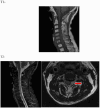Case report: a patient with spontaneous spinal epidural hematoma recovered after conservative treatment
- PMID: 39967594
- PMCID: PMC11832481
- DOI: 10.3389/fmed.2025.1509903
Case report: a patient with spontaneous spinal epidural hematoma recovered after conservative treatment
Abstract
Spontaneous spinal epidural hematoma is a rare condition, akin to a stroke, which can manifest as hemiplegia. It cannot be diagnosed by head CT scan and is prone to misdiagnosis as a cerebral stroke, potentially leading to the activation of thrombolysis and exacerbation of the condition. This paper reports a case of a patient with this disease, a 68 years-old male who presented with sudden neck pain weakness, and numbness in the left limbs for 2 h. The symptoms were similar to those of a stroke. A head CT scan showed no significant abnormalities, but the clinical presentation of neck pain alerted the physician, who did not hastily administer thrombolysis. Instead, they quickly performed further examinations, including neck vessel ultrasound and neck CT/MRI, to rule out a cerebral stroke. The patient was ultimately diagnosed with spontaneous spinal epidural hematoma in the neck. The patient was transferred to the ICU for conservative treatment, and a follow-up neck MRI the next day revealed a significant reduction in the hematoma, with a corresponding improvement in clinical symptoms. This case report supports the diagnostic value of CT scans for spinal epidural hematoma and shares a conservative treatment plan for patients with high spinal cord lesions.
Keywords: case report; conservative treatment; spontaneous spinal epidural hematoma; stroke; stroke mimic.
Copyright © 2025 Cheng, Li, Liu, Liu and Zhao.
Conflict of interest statement
The authors declare that the research was conducted in the absence of any commercial or financial relationships that could be construed as a potential conflict of interest.
Figures




References
-
- Babayev R, Ekşi MŞ. Spontaneous thoracic epidural hematoma: A case report and literature review. Childs Nerv Syst. (2016) 32:181–7. - PubMed
-
- Zhong W, Chen H, You C, Li J, Liu Y, Huang S, et al. Spontaneous spinal epidural hematoma. J Clin Neurosci. (2011) 18:1490–4. - PubMed
-
- Stetkarova I, Ehler E, Brabec K, Jelinkova L, Chylova M, Weichet J, et al. Spontaneous spinal epidural haematoma:management and main risk factors in era of anticoagulant/antiplatelet treatment. Neurol Neurochirurgia Polska. (2021) 55(6):574–81. - PubMed
-
- Beatty R, Winston K. Spontaneous cervical epidural hematoma: A consideration of etiology. J Neurosurg. (1984) 61(1):143–8. - PubMed
Publication types
LinkOut - more resources
Full Text Sources

